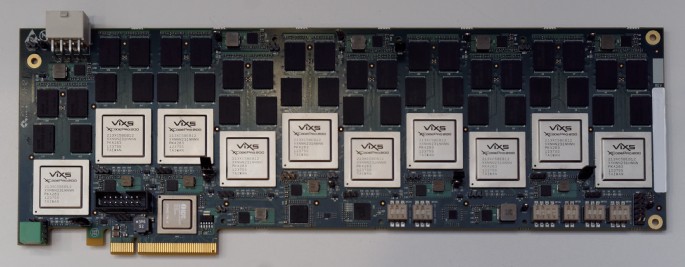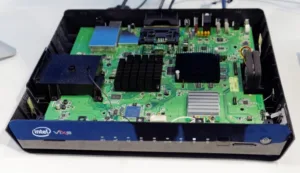Vixs was in a positive mood at IBC, as it had been at CES, as it has currently the “only fully working UltraHD HEVC chip in production”. The XCode 6400 chip is in five shipping products including units from Sharp and Panasonic. The company is also happy as it can support Rec 2020 colour (as well as Rec. 709 and DCI-P3) and it can support Dolby Vision or other HDR schemes. The key to this is that Vixs’ chip is a special purpose processor that can be re-programmed for different applications, although some general algorithms are in hardware.
The company has developed a “golden reference box” that was being used by Harmonix and Cisco among others to demonstrate UltraHD from HEVC. The box supports the HEVC 4K Main 10 profile.
Vixs told us that as well as being relatively flexible compared to a traditional SoC approach, the company’s technology is relatively low power, with just 7W to 8W being used for a single processor, much less than software-based solutions which typically use much more power. That becomes important where companies are trying to develop USB-power UltraHD or HEVC solutions.
The company has developed a range of chips in the 6400 family, with the 6406 being for “headless” gateways, the 6404 for small boxes, the 6402 for HDD-based PVRs and the 6401 for low cost HEVC “zappers”. All support 10 bit decoding.
We commented on the fact that Intel was showing a reference design using a Vixs chip on its booth in our “Round-up”. The reference design is for a “headed” gateway for Docsis 3.0. The Intel chip runs the gateway functions, while the Vixs chip is running as a client, but tightly coupled to the Intel chip. Of course, it helps for Intel to be able to have a partner for the design that it doesn’t compete with in the STB SoC business!
We first started talking to Vixs a few years ago when it was talking a lot about transcoding and its importance in the future. That remains a key strength and there is a lot of interest in systems built around Android and HTML5 and MPEG-DASH. The company sees itself having a lot of strength in that area and there will be announcements next year – perhaps at CES?
There was a demonstration of an MOCA application using the company’s chips. There is not much of a market for MOCA in Europe as coax distribution is less widely used, but it is used in Multi-dwelling Units (MDUs) such as apartment blocks.
Next we looked at the XCode Pro 100 chip being used in broadcast and professional applications for encoding, decoding and transcoding. It expects the hardware to be used at the “edge of the cloud” by broadcasters. Mystic Video was in the suite to show its rack systems, built on the chips, which can support 40HD or 80SD streams in a single 1U rack unit. Features supported include audio and video transcoding, along with PIP (Picture in Picture) creation, multiscreen transcoding, packaging, encryption and HTTP streaming to CDNs. The solution has passed the Ericsson Mediaroom Encoder Conformance Test (ECT) which ensures interoperability of headend equipment used in Ericsson Mediaroom deployments.
Finally, the XCode Pro 400 will offer HEVC realtime encoding and will be available “next year”.
Display Daily Comments
We had a long chat about Dolby Vision and other approaches to HDR. One of the downsides of Dolby Vision is that the additional 2 bits of data in the extra Dolby layer add around 20% to the bitrate of the stream compared to standard approaches. The extra processing is also a challenge for traditional SoCs and Vixs believes that everyone showing Dolby Vision displays is currently using FPGAs or co-processors. That fits with what we heard from Dolby at Berlin, that Sigma would be the first to have an SoC solution. (BR)


